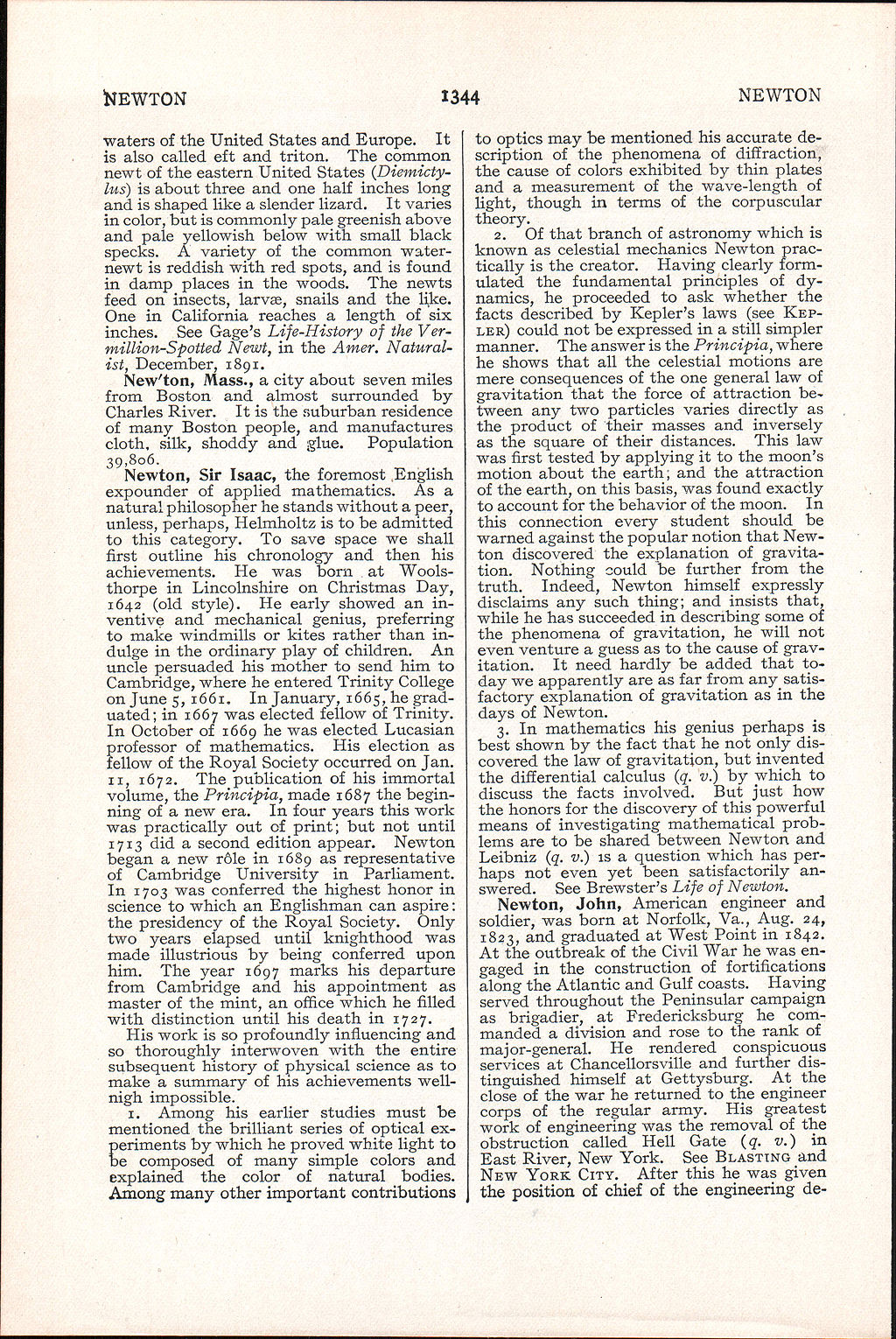waters of the United States and Europe. It is also called eft and triton. The common newt of the eastern United States (Diemictylus) is about three and one half inches long and is shaped like a slender lizard. It varies in color, but is commonly pale greenish above and pale yellowish below with small black specks. A variety of the common water-newt is reddish with red spots, and is found in damp places in the woods. The newts feed on insects, larvæ, snails and the like. One in California reaches a length of six inches. See Gage's Life History of the Vermillion-Spotted Newt, in the Amer. Naturalist, December, 1891.
New′ton, Mass., a city about seven miles from Boston and almost surrounded by Charles River. It is the suburban residence of many Boston people and manufactures cloth, silk, shoddy and glue. Population 39,806.
Newton, Sir Isaac, the foremost English expounder of applied mathematics. As a natural philosopher he stands without a peer, unless, perhaps, Helmholtz is to be admitted to this category. To save space we shall first outline his chronology and then his achievements. He was born at Woolsthorpe in Lincolnshire on Christmas Day, 1642 (old style). He early showed an inventive and mechanical genius, preferring to make windmills or kites rather than indulge in the ordinary play of children. An uncle persuaded his mother to send him to Cambridge, where he entered Trinity College on June 5, 1661. In January, 1665, he graduated; in 1667 was elected fellow of Trinity. In October of 1669 he was elected Lucasian professor of mathematics. His election as fellow of the Royal Society occurred on Jan. 11, 1672. The publication of his immortal volume, the Principia, made 1687 the beginning of a new era. In four years this work was practically out of print; but not until 1713 did a second edition appear. Newton began a new rôle in 1689 as representative of Cambridge University in Parliament. In 1703 was conferred the highest honor in science to which an Englishman can aspire: the presidency of the Royal Society. Only two years elapsed until knighthood was made illustrious by being conferred upon him. The year 1697 marks his departure from Cambridge and his appointment as master of the mint, an office which he filled with distinction until his death in 1727.
His work is so profoundly influencing and so thoroughly interwoven with the entire subsequent history of physical science as to make a summary of his achievements well-nigh impossible.
1. Among his earlier studies must be mentioned the brilliant series of optical experiments by which he proved white light to be composed of many simple colors and explained the color of natural bodies. Among many other important contributions to optics may be mentioned his accurate description of the phenomena of diffraction, the cause of colors exhibited by thin plates and a measurement of the wave-length of light, though in terms of the corpuscular theory.
2. Of that branch of astronomy which is known as celestial mechanics Newton practically is the creator. Having clearly formulated the fundamental principles of dynamics, he proceeded to ask whether the facts described by Kepler's laws (see Kepler) could not be expressed in a still simpler manner. The answer is the Principia, where he shows that all the celestial motions are mere consequences of the one general law of gravitation that the force of attraction between any two particles varies directly as the product of their masses and inversely as the square of their distances. This law was first tested by applying it to the moon's motion about the earth; and the attraction of the earth, on this basis, was found exactly to account for the behavior of the moon. In this connection every student should be warned against the popular notion that Newton discovered the explanation of gravitation. Nothing could be further from the truth. Indeed, Newton himself expressly disclaims any such thing; and insists that, while he has succeeded in describing some of the phenomena of gravitation, he will not even venture a guess as to the cause of gravitation. It need hardly be added that today we apparently are as far from any satisfactory explanation of gravitation as in the days of Newton.
3. In mathematics his genius perhaps is best shown by the fact that he not only discovered the law of gravitation, but invented the differential calculus (q. v.) by which to discuss the facts involved. But just how the honors for the discovery of this powerful means of investigating mathematical problems are to be shared between Newton and Leibniz (q. v.) is a question which has perhaps not even yet been satisfactorily answered. See Brewster's Life of Newton.
Newton, John, American engineer and soldier, was born at Norfolk, Va., Aug. 24, 1823, and graduated at West Point in 1842. At the outbreak of the Civil War he was engaged in the construction of fortifications along the Atlantic and Gulf coasts. Having served throughout the Peninsular campaign as brigadier, at Fredericksburg he commanded a division and rose to the rank of major-general. He rendered conspicuous services at Chancellorsville and further distinguished himself at Gettysburg. At the close of the war he returned to the engineer corps of the regular army. His greatest work of engineering was the removal of the obstruction called Hell Gate (q. v.) in East River, New York. See Blasting and New York City. After this he was given the position of chief of the engineering de-
